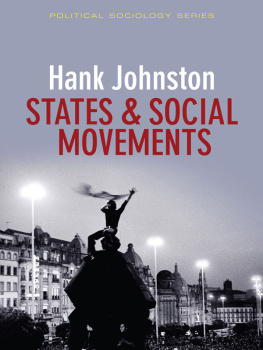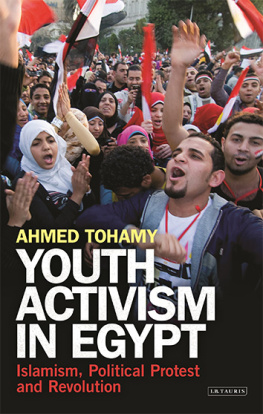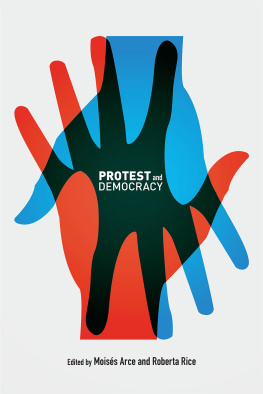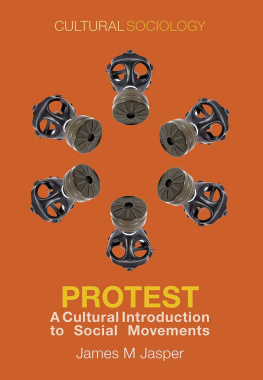Stanford University Press
Stanford, California
2012 by the Board of Trustees of the Leland Stanford Junior University. All rights reserved.
No part of this book may be reproduced or transmitted in any form or by any means, electronic or mechanical, including photocopying and recording, or in any information storage or retrieval system without the prior written permission of Stanford University Press.
Printed in the United States of America on acid-free, archival-quality paper
Library of Congress Cataloging-in-Publication Data
Contention in context : political opportunities and the emergence of protest / edited by Jeff Goodwin and James M. Jasper.
pages cm
Includes bibliographical references and index.
ISBN 978-0-8047-7611-0 (cloth : alk. paper)--ISBN 978-0-8047-7612-7 (pbk. : alk. paper)
1. Social movements. 2. Protest movements. 3. Political science. I. Goodwin, Jeff, editor of compilation. II. Jasper, James M., 1957-editor of compilation.
HM881.C655 2011
322.4--dc23
2011026604
Typeset by Bruce Lundquist in 10/14 Minion
E-book ISBN: 978-0-8047-7893-0
Preface
JAMES M. JASPER
IN COLLEGE I heard a charming story about George Santayana, that great thinker but forgotten philosopher. He was lecturing at Harvard one bright spring day, forty-eight years old and at the height of his fame, when he looked out the window and allowed his words to trail off. He walked out of the lecture hall, booked passage to Europe, and spent the last forty years of his life in Rome. I thought of Santayana when I had lunch one day with Jeff Goodwin in September 2008. We were sitting outdoors in what I think of as Roman weather when he pushed a manuscript across the table to me. He was leaving for Florence the next day, and asked me to help him finish this complex book project. (I expected him back in a year, but hey, you never know.)
Jeff had invited seventeen scholars to each read an important book on a revolutionary or social movement, asking what political opportunity structures contributed to its emergence. Then he asked the authors of the books to respond, and ten did. The response was so enthusiasticand the exchanges so lengthythat Jeff had more materials than any sane editor would accept for publication. It needed to be cut in half, something Jeff didnt have the heart to do. I ruthlessly suggested we publish only full exchanges, even though that meant losing several wonderful essays, and then ask the original critics to write a rejoinder to update the discussion and suggest new directions for research. (There was one exception: the U.S. civil rights movement, too important to skip even though Charles Payne declined to reply.) Two additional exchanges were withdrawn because the authors thought them outdated. Jeff and I would like to thank all the participants whose patient work did not end up in the published version: Said Arjomand, Nicola Beisel, Kathleen Blee, Chris Bonastia, Mark Chaves, Nina Eliasoph, Tina Fetner, Joseph Gerteis, John Glenn III, Doug Guthrie, Ernest Harsch, Charles Kurzman, Paul Lichterman, Rory McVeigh, Kelly Moore, Misagh Parsa, Kurt Schock, and Mark Thompson.
After languishing for nearly a decade (I knew, since I was one of the original contributors), the book also needed updating. For instance, Chuck Tilly, the great scholar of political process who had died only a few months before, had issued a torrent of books in his final years that touched on various dimensions of the external contexts for social movements and protest. Once we had the contract from Stanford University Press, we could ask the scholars to go back and revise their original contributions in light of subsequent intellectual developments like this.
We also asked Jan Willem Duyvendak (writing with Christian Brer) to contribute a new chapter, since the tradition of political opportunity structures that his work represents differs from American use of the concept. Donatella della Porta was willing to contribute a piece showing her important extensions of political-opportunity theories. I would also like to thank Geoffrey Blank, Nico Legewie, and especially Kevin Moran for their editorial persistence in pulling the manuscript together, and the CUNY Graduate Center Department of Sociology for paying them to help me. Olivier Fillieule and Verta Taylor read the entire manuscript and offered extremely useful suggestions. At Stanford University Press, Kate Wahl was a model of efficiency as well as good judgment, and Joa Suorez was invaluable in directing the flow of paper and computer files during the final stages of preparation.
Despite its prolonged gestation, this volume should help us think about current trends in social movement theory. The concept of political opportunity structures is alive and well in journal articles, with many of the same conceptual problems it has always had. In social science broadly, however, there has been a marked swing of the intellectual pendulum from structure to agency in the past decade or so. In the field of social movements this has resulted in studies of meaning, emotions, and strategic choices. It is important not to forget the causal impact of structured contexts on how protest unfolds and in some cases even changes the world. Yet while recognizing the role of structural context, we can also rethink that role, casting structures in a new vision of the world around us as ever changing, ever open to human efforts. Structures and opportunities, we might say, neither enable nor constrain our actions. They are our actions, since we cannot have structures without action in them, or have action without the resources and channels through which it unfolds.
I think of myself as a writer as much as a social scientist, and so I care about how people use words. I devote a lot of time to editing other peoples work, on the lookout for the abuse of words or ideas. Much of the debate over political opportunities and structures has been a battle over language, and as such it can never be fully resolved empirically. The most concrete predictions of any perspective are only testable if the concepts and words make sense. There is a tendency in studies of social movements to prefer empirical research to theory, but we need both. We need assessments of our language and concepts for their internal consistency, their logic, and their resonance with various audiences. Clearing the conceptual underbrush is a task that is never complete.
Chuck Tilly would probably smile at my Santayana story, knowing the truth behind it. There was nothing spontaneous in Santayanas decision to retire at forty-eight; he had been planning this for years. He had waited to come into the resources, namely a ten thousand dollar bequest from his mother, which allowed him to do it. And he didnt steam directly to Italy, but to Britain. He had not yet decided where to live, and he was kept from the Continent for four years as the nation states of Europe did what they had always done, wage war. Because Chuck helped us understand these processes, and so many more, we dedicate this book to his memory.







